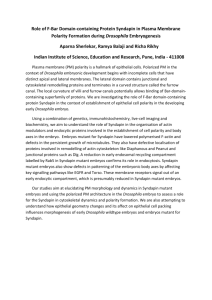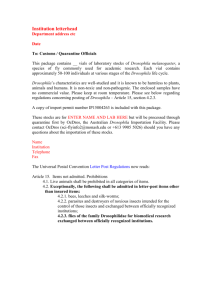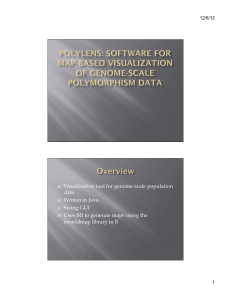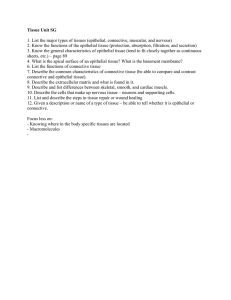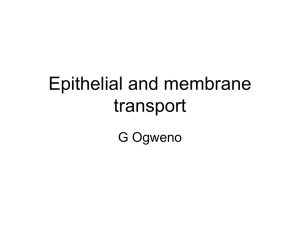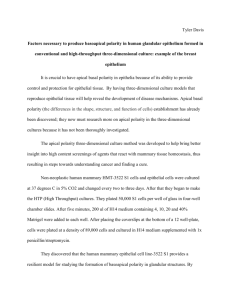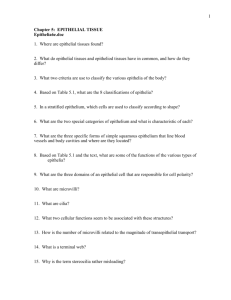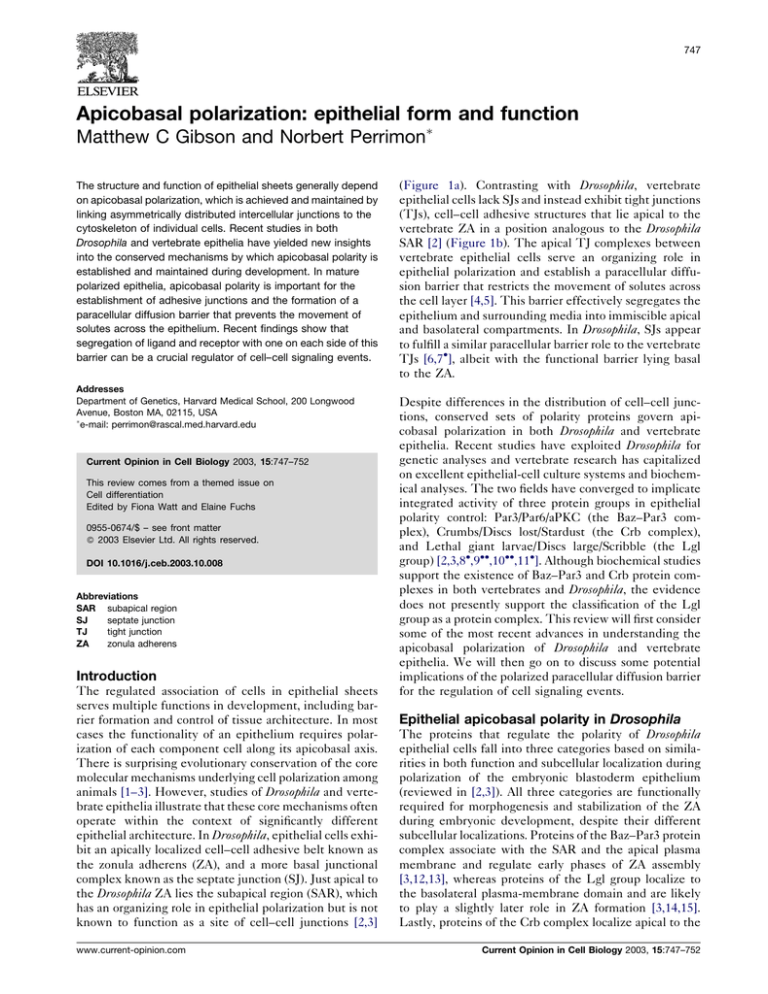
747
Apicobasal polarization: epithelial form and function
Matthew C Gibson and Norbert Perrimon
The structure and function of epithelial sheets generally depend
on apicobasal polarization, which is achieved and maintained by
linking asymmetrically distributed intercellular junctions to the
cytoskeleton of individual cells. Recent studies in both
Drosophila and vertebrate epithelia have yielded new insights
into the conserved mechanisms by which apicobasal polarity is
established and maintained during development. In mature
polarized epithelia, apicobasal polarity is important for the
establishment of adhesive junctions and the formation of a
paracellular diffusion barrier that prevents the movement of
solutes across the epithelium. Recent findings show that
segregation of ligand and receptor with one on each side of this
barrier can be a crucial regulator of cell–cell signaling events.
Addresses
Department of Genetics, Harvard Medical School, 200 Longwood
Avenue, Boston MA, 02115, USA
e-mail: perrimon@rascal.med.harvard.edu
Current Opinion in Cell Biology 2003, 15:747–752
This review comes from a themed issue on
Cell differentiation
Edited by Fiona Watt and Elaine Fuchs
0955-0674/$ – see front matter
ß 2003 Elsevier Ltd. All rights reserved.
DOI 10.1016/j.ceb.2003.10.008
Abbreviations
SAR subapical region
SJ
septate junction
TJ
tight junction
ZA
zonula adherens
Introduction
The regulated association of cells in epithelial sheets
serves multiple functions in development, including barrier formation and control of tissue architecture. In most
cases the functionality of an epithelium requires polarization of each component cell along its apicobasal axis.
There is surprising evolutionary conservation of the core
molecular mechanisms underlying cell polarization among
animals [1–3]. However, studies of Drosophila and vertebrate epithelia illustrate that these core mechanisms often
operate within the context of significantly different
epithelial architecture. In Drosophila, epithelial cells exhibit an apically localized cell–cell adhesive belt known as
the zonula adherens (ZA), and a more basal junctional
complex known as the septate junction (SJ). Just apical to
the Drosophila ZA lies the subapical region (SAR), which
has an organizing role in epithelial polarization but is not
known to function as a site of cell–cell junctions [2,3]
www.current-opinion.com
(Figure 1a). Contrasting with Drosophila, vertebrate
epithelial cells lack SJs and instead exhibit tight junctions
(TJs), cell–cell adhesive structures that lie apical to the
vertebrate ZA in a position analogous to the Drosophila
SAR [2] (Figure 1b). The apical TJ complexes between
vertebrate epithelial cells serve an organizing role in
epithelial polarization and establish a paracellular diffusion barrier that restricts the movement of solutes across
the cell layer [4,5]. This barrier effectively segregates the
epithelium and surrounding media into immiscible apical
and basolateral compartments. In Drosophila, SJs appear
to fulfill a similar paracellular barrier role to the vertebrate
TJs [6,7], albeit with the functional barrier lying basal
to the ZA.
Despite differences in the distribution of cell–cell junctions, conserved sets of polarity proteins govern apicobasal polarization in both Drosophila and vertebrate
epithelia. Recent studies have exploited Drosophila for
genetic analyses and vertebrate research has capitalized
on excellent epithelial-cell culture systems and biochemical analyses. The two fields have converged to implicate
integrated activity of three protein groups in epithelial
polarity control: Par3/Par6/aPKC (the Baz–Par3 complex), Crumbs/Discs lost/Stardust (the Crb complex),
and Lethal giant larvae/Discs large/Scribble (the Lgl
group) [2,3,8,9,10,11]. Although biochemical studies
support the existence of Baz–Par3 and Crb protein complexes in both vertebrates and Drosophila, the evidence
does not presently support the classification of the Lgl
group as a protein complex. This review will first consider
some of the most recent advances in understanding the
apicobasal polarization of Drosophila and vertebrate
epithelia. We will then go on to discuss some potential
implications of the polarized paracellular diffusion barrier
for the regulation of cell signaling events.
Epithelial apicobasal polarity in Drosophila
The proteins that regulate the polarity of Drosophila
epithelial cells fall into three categories based on similarities in both function and subcellular localization during
polarization of the embryonic blastoderm epithelium
(reviewed in [2,3]). All three categories are functionally
required for morphogenesis and stabilization of the ZA
during embryonic development, despite their different
subcellular localizations. Proteins of the Baz–Par3 protein
complex associate with the SAR and the apical plasma
membrane and regulate early phases of ZA assembly
[3,12,13], whereas proteins of the Lgl group localize to
the basolateral plasma-membrane domain and are likely
to play a slightly later role in ZA formation [3,14,15].
Lastly, proteins of the Crb complex localize apical to the
Current Opinion in Cell Biology 2003, 15:747–752
748 Cell differentiation
Figure 1
(a)
SAR
(b)
TJ
ZA
ZA
SJ
(c)
(d)
Baz Par6
PATJ
Crb
PALS1
aPKC
T
J
Sdt
Dlt
Par6 aPKC
Par3-Baz
Crb
Par3-Baz
Active complex
Z
A
Par6
Dlg
Scrib
Lgl
Par6
aPKC
aPKC
Lgl
Lgl
P
Inactive complex
Insect (Drosophila)
Vertebrate
Current Opinion in Cell Biology
Distribution and activity of polarity complexes in Drosophila and vertebrate epithelia [2,3]. (a) Drosophila epithelial cells exhibit two principal
sets of junctions: adherens junctions, which form the ZA (red), and SJs (blue). Proteins of the Lgl group localize at or below the level of the SJ. The
SAR (green) lies apical to the ZA in a position analogous to the vertebrate TJ. Proteins of the Drosophila Crb and Baz–Par3 complexes localize to
the SAR, or marginal zone. (b) Vertebrate epithelia exhibit a ZA (red), as well as a slightly more apical TJ complex (green) [2]. Both the vertebrate Crb
and Baz–Par3 complexes localize to the TJ, which is perhaps consistent with a conserved function of the vertebrate TJ and Drosophila SAR.
(c) Model for the activity of polarity protein complexes in Drosophila epithelial polarization and ZA morphogenesis, adapted from [8,9]. (d) Model
for the activity of polarity protein complexes in mammalian epithelia, adapted from [10,11]. Here, mLgl binds and inactivates Par6/aPKC in the lateral
plasma membrane domain, but dissociates upon phosphorylation by aPKC. Par6/aPKC is then free to bind Par3 and form an active complex [11] that
mediates TJ morphogenesis through interactions between Par6 and PALS1 of the Crb complex [10].
ZA and regulate later phases of ZA maturation and
stabilization [3,16–18]; this occurs at least in part via
Crb-mediated recruitment of the actin-binding protein
Dmoesin and components of the apical Spectrin-based
membrane cytoskeleton [19]. Although it is has been
widely accepted that each of these three protein groups
participates in cell polarization, it has only recently
become clear how they might collaborate to produce a
unified network that governs epithelial polarization in
diverse organismal systems.
The transmembrane protein Crb is considered to be a
crucial apical determinant on the basis of its ability to
confer apical-membrane identity to basolateral memCurrent Opinion in Cell Biology 2003, 15:747–752
branes [20]. In Drosophila, crb misexpression causes apicalization of cells and consequently gross defects in
epithelial organization. A mutant screen for enhancers
of the crb misexpression phenotype identified lgl, suggesting a negative regulatory interaction between the Crb and
Lgl complexes in epithelial polarization [9]. This notion
is reinforced by the converse observation that the crb lossof-function phenotype, embryonic epithelial disintegration, is partially rescued by concomitant loss of dlg, lgl or
scrib, and that the sdt mutant phenotype, which is similar
to that of crb, is partially rescued by mutations in lgl or dlg
[8,9]. Together, these experiments show that basolateral Lgl group proteins counteract the apicalizing activity
of the Crb complex (Figure 1c), although the precise
www.current-opinion.com
Apicobasal polarization: epithelial form and function Gibson and Perrimon 749
mechanism of interaction remains poorly resolved. To
date, there are no documented biochemical interactions
between members of the Lgl and Crb groups in Drosophila, which may indicate that the Lgl group antagonizes
apical polarization independent of Crb activity or indirectly regulates the Crb complex through interactions with
Baz/Par6/aPKC [8,9]. Indeed, Lgl has been shown to
bind Par6/aPKC independent of Baz in both Drosophila
neuroblasts [21] and mammalian epithelia [11,22], suggesting a regulatory mechanism by which Lgl complex
proteins could antagonize the formation or activity of the
Baz/Par6/aPKC complex in lateral membrane domains.
Studies of Drosophila embryonic epithelia are thus beginning to reveal a genetic hierarchy by which the Baz–Par3,
Crb, and Lgl groups integrate to regulate ZA morphogenesis and epithelial cell polarity. However, phenotypic
analysis indicates that this system only operates in a
narrow temporal window [9] that follows the actual
initiation of apicobasal polarity during earlier developmental stages. In Drosophila, early embryonic development is syncytial and the blastoderm epithelium forms de
novo through a process known as cellularization. Following fertilization, zygotic nuclei undergo 13 syncytial
mitoses (to number 5000), migrate to the surface plasma
membrane, and subsequently become encased by polarized invaginations of the plasma membrane known as
furrow canals. During cellularization, the furrow canals
expand as a result of polarized insertion of newly synthesized plasma membrane [23], and adjacent cells begin to
form polarized cell–cell contacts [24]. Hence, some
aspects of apicobasal polarity are in effect before the
completion of cellularization.
Analysis of large chromosomal aberrations reveals that
relatively few genes are zygotically required for the
process of cellularization, indicating that a large portion
of the initial polarity machinery is provided by maternal
contributions. Among the few genes zygotically required
for cellularization is the newly described locus, slow as
molasses (slam) [25,26]. Slam protein associates with the
plasma membrane and shows a polarized distribution in
the furrow canals. Perhaps more importantly, slam loss-offunction specifically impairs growth of the basolateral
plasma membrane domain and disrupts polarized localization of important junctional proteins such as Armadillo/
b-Catenin and the PDZ protein encoded by discs lost (dlt,
a member of the Crb complex). These and additional
findings imply that slam plays an early and essential role
in the specification of distinct membrane domains that
form during cellularization, perhaps by mobilizing an
inert maternally-supplied polarity apparatus [25]. A
remaining question is how directly Slam controls the
localization of proteins such as Dlt, which is itself implicated in the establishment of polarity and discrete apical
and lateral plasma-membrane domains [27]. Future studies into the molecular mode of action of slam and other
www.current-opinion.com
loci zygotically required for cellularization should provide crucial insight into links between the initial polarity
cues and later-acting networks that govern ZA formation
and stabilization.
Epithelial apicobasal polarity in mammals
Investigations of apicobasal polarization in mammalian
epithelia have revealed striking parallels with Drosophila.
Vertebrate epithelial cells lack SJs, but instead feature
TJs in a region analogous to the Drosophila SAR [2,3].
Members of the vertebrate Par3–Baz complex (Par3/Par6/
aPKC) localize to the TJ [28,29] and members of both the
Par3–Baz and Crb complexes are implicated in TJ formation [10]. Although the homologous fly complexes
are known to colocalize and interact genetically, experiments in mammalian cell culture document direct physical interaction between these protein complexes on the
basis of co-immunoprecipitation of PALS1 (the homologue of Drosophila sdt) with Par6. On a functional level,
overexpression of Par6 inhibits the TJ localization of
PALS1, and expression of dominant-negative PATJ (a
member of the vertebrate Crb complex) causes mislocalization of aPKC away from the TJ in MDCK cells [10].
These results reveal direct interactions between the Crb/
PALS1/PATJ and PAR3/PAR6/aPKC complexes during
cell polarization and TJ formation, outlining a mechanism
by which Crb could act through PALS1 to recruit the
Par3–Baz complex to the apical TJ complex of vertebrate
epithelia (Figure 1d).
Just as Par3–Baz complexes localize to the TJ (an apical
domain analogous to the insect SAR), vertebrate homologues of the Drosophila Lgl group are excluded from the
TJ and localize to the lateral plasma membrane in polarized epithelial cells [11,29,30]. Despite its basolateral
localization, recent reports indicate that mammalian Lgl
(mLgl) can bind Par6b and aPKC exclusive of Par3 in
immunoprecipitates of several different types of tissue
culture cells [11,22]. These results document the existence of at least two distinct Par6/aPKC complexes in
epithelial cells: ‘active’ complexes of Par3/Par6/aPKC,
and ‘inactive’ complexes of mLgl/Par6/aPKC. Intriguingly, basolateral mLgl does not normally co-localize with
Par6b/aPKC in polarized MDCK cells, but does transiently co-localize with Par6b/aPKC during the early stages
of cell repolarization induced by calcium [11]. During
this transient co-localization, mLgl becomes phosphorylated (perhaps by aPKC [11,22]) and then dissociates
from the complex, permitting formation of the ‘active’
Par3/Par6/aPKC complex and the subsequent events
leading to TJ morphogenesis [11] (Figure 1d). These
findings suggest a general model for polarity control
remarkably similar to what has been observed in Drosophila: opposing apical and basolateral protein groups
position cell–cell junctions at the boundary between
apical and basolateral plasma membrane domains. It is
interesting to note that, in Drosophila, Lgl also binds Par6/
Current Opinion in Cell Biology 2003, 15:747–752
Figure 2
(a)
aPKC independently of Baz–Par3 and becomes phosphorylated by aPKC during neuroblast polarization
[21]. Par6/aPKC is also clearly shown to regulate mLgl
by phosphorylation in non-epithelial mammalian cell
lines [22]. Whether similar interactions between Par6/
aPKC and Lgl also occur in Drosophila epithelial cells
remains unknown, but seems quite probable.
Apicobasal polarity: signaling implications
It is clear that a great deal of cellular energy is invested in
epithelial cell polarization, but to what end? A wellestablished role of the polarity apparatus is to position
the junctional complexes that maintain tissue integrity
and act as scaffolds for transmembrane adhesion and
signal transduction molecules [1–3]. For example, one
recent analysis elegantly demonstrates that Wnt and BMP
signaling govern hair follicle morphogenesis in mammalian epithelia by locally modulating a switch from
E- to P-cadherin expression in epithelial TJs [31]. A
less-considered but equally crucial role for the polarity
apparatus may be to delimit separate apical and basolateral microenvironments within an epithelium. The immiscibility of apical and basolateral plasma membrane
domains together with the diffusion barrier properties of
some junctional complexes allows for targeted secretion
of extracellular signals to the apical or basal compartments
of an epithelium. This possibility presents an intriguing
new level of complexity in cell–cell communication.
(b)
Some of the earliest studies to hint at the importance of
apicobasal polarization in cell–cell signaling came from
analysis of EGFR signaling during vulva induction by the
Lin-3/TGF-a ligand in C. elegans. Genetic analysis has
identified several additional genes required for EGFR
function in C. elegans, many of which seem to function in
basolateral localization of the receptor [32,33]. Vertebrates also feature a family of EGFR-like receptors,
known as ErbB1–4. These receptors also show polarized
subcellular distribution in epithelia, and in some cases are
known to generate qualitatively distinct signaling activities depending on their localization [34]. Binding of
ligands such as Heregulin or EGF stimulates the heterodimerization and phosphorylation of ErbB receptors,
initiating a downstream signaling cascade [35]. Surprisingly, analysis of cultured human airway epithelia reveals
that the ligand Heregulin is secreted into the apical
(c)
Heregulin
ErbB2
TJ
Phospho-ErbB2
Current Opinion in Cell Biology
Current Opinion in Cell Biology 2003, 15:747–752
The paracellular diffusion barrier regulates Heregulin activation of ErbB2
in mammalian epithelia. (a) In control epithelium, Heregulin is found in
the apical extracellular space. The transmembrane receptor ErbB2 is
confined to basolateral membranes below the TJs and thus the
receptor is inactive. (b) When the paracellular diffusion barrier is
compromised by addition of calcium to the culture media, apical
Heregulin is able to activate ErbB2, leading to its phosphorylation and
activation of signal transduction. (c) When epithelial integrity is
disrupted by wounding, apical ligand and basolateral receptors come
into contact, stimulating receptor activation and a proliferative woundhealing response [36].
www.current-opinion.com
Apicobasal polarization: epithelial form and function Gibson and Perrimon 751
extracellular space above the TJ level, whereas its receptor ErbB2 is localized to the basolateral plasma membrane
domain below the TJ. Analysis of ErbB2 activation in
control airway epithelia suggests that apical Heregulin
cannot activate ErbB2, even when exogenous ligand is
applied to the apical epithelial surface (Figure 2a). Conversely, addition of Heregulin to the basolateral side of
cultured airway epithelia stimulates high levels of receptor activation and hence epithelial remodeling. Finally,
when the paracellular diffusion barrier is compromised by
calcium addition, apically applied ligand can access and
activate basolateral ErbB2, demonstrating that physical
segregation of receptor and ligand normally prevents
receptor activation (Figure 2b) [36].
These observations explain how airway epithelia can
constitutively express a mitogenic ligand but still feature
a low level of receptor activation, but do not address the
biological significance of a ligand/receptor pair that is
physically segregated under normal conditions. The
answer to this apparent paradox could lie in the delicate
nature of airway epithelia and their vital function in
presenting a barrier to microbial or viral attack. When
pathogens or irritants physically compromise epithelial
integrity, apical Heregulin could move into the basolateral space and activate ErbB2 to stimulate an immediate
wound response [36] (Figure 2c). This model is largely
borne out by the ability of antibodies that block the
functions of ErbB2 and Heregulin to abolish the proliferative wound-healing response of epithelia injured in
vitro [36].
The finding that basolateral application of Heregulin
induces severe epithelial abnormalities demonstrates
that dysplastic disease states could arise from physical
disruption of the epithelial paracellular diffusion barrier.
Consistent with this idea, it was recently reported that
infection of mammalian epithelial cells with Heliobacter
pylori causes disruption of the paracellular diffusion barrier, among other effects [37]. The long-term implications of H. pylori infection may include gastric carcinoma
and peptic ulcer disease. Some aspects of these disease
states could result from the inappropriate movement of
solutes between apical and basolateral aspects of infected
epithelia. It is also interesting to consider whether ligand/
receptor segregation plays a role in developmental cell–
cell signaling. A major distinction between vertebrate and
insect epithelia is the relative position of the paracellular
diffusion barrier. In Drosophila, genetic studies suggest
that the epithelial diffusion barrier is mediated by the SJ
basal to the ZA [6,7]. We note that flies mutant for the
SJ-localized polarity proteins dlg, scrib and lgl exhibit a
dramatic overproliferation of imaginal disc epithelial cells
[38]. Conceivably, this phenotype could result from disruption of the paracellular barrier and enhanced cell
proliferation due to mixing of a mitogenic ligand/receptor
pair that is segregated under normal conditions.
www.current-opinion.com
Conclusions
Recent studies demonstrate that conserved molecular
machinery governs apicobasal polarization of Drosophila
and vertebrate epithelial cells. In both systems, a delicate balance between competing protein complexes
defines the position of cell–cell junctions at the interface
between apical and basolateral plasma membrane
domains. One of the consequences of apicobasal polarization is establishment of a paracellular diffusion barrier
mediated by the vertebrate TJ or the SJ in Drosophila.
Recent studies demonstrate that segregation of ligand/
receptor pairs to either side of this barrier may represent
an important new level of regulation in cell–cell signaling events.
References and recommended reading
Papers of particular interest, published within the annual period of
review, have been highlighted as:
of special interest
of outstanding interest
1.
Nelson WJ: Adaptation of core mechanisms to generate cell
polarity. Nature 2003, 422:766-774.
2.
Knust E, Bossinger O: Composition and formation of
intercellular junctions in epithelial cells. Science 2002,
298:1955-1959.
3.
Tepass U, Tanentzapf G, Ward R, Fehon R: Epithelial cell polarity
and cell junctions in Drosophila. Annu Rev Genet 2001,
35:747-784.
4.
Tsukita S, Furuse M: Claudin-based barrier in simple and
stratified cellular sheets. Curr Opin Cell Biol 2002,
14:531-536.
5.
Tsukita S, Furuse M, Itoh M: Multifunctional strands in tight
junctions. Nat Rev Mol Cell Biol 2001, 2:285-293.
6.
Lamb RS, Ward RE, Schweizer L, Fehon RG: Drosophila coracle, a
member of the protein 4.1 superfamily, has essential structural
functions in the septate junctions and developmental functions
in embryonic and adult epithelial cells. Mol Biol Cell 1998,
9:3505-3519.
Genova JL, Fehon RG: Neuroglian, Gliotactin, and the NaR/KR
ATPase are essential for septate junction function in
Drosophila. J Cell Biol 2003, 161:979-989.
A genetic screen is employed to identify genes required for paracellular
barrier formation in the Drosophila salivary gland. Mutations disrupting
the paracellular barrier are shown to correlate with ultrastructural defects
in epidermal septate junctions. Interactions among several newly described components of the SJ are considered in detail.
7.
8.
Bilder D, Schober M, Perrimon N: Integrated activity of PDZ
protein complexes regulates epithelial polarity. Nat Cell Biol
2003, 5:53-58.
This article, along with [9], establishes a genetic hierarchy by which
three protein complexes interact to establish apicobasal polarity in the
Drosophila epidermis. A central finding is that opposing activities of
basolateral Scrib and apical Crb complxes define distinct plasma membrane domains and thus set the position of cell–cell junctions.
9.
Tanentzapf G, Tepass U: Interactions between the crumbs,
lethal giant larvae and bazooka pathways in epithelial
polarization. Nat Cell Biol 2003, 5:46-52.
The authors employ a genetic screen to identify interactions between
apical Crb and basolateral Lgl complexes during epithelial polarization.
Further experiments, along with [8], establish that the Crb complex and
Lgl group competitively function to define apical and basolateral membrane domains, respectively.
10. Hurd TW, Gao L, Roh MH, Macara IG, Margolis B: Direct
interaction of two polarity complexes implicated in epithelial
tight junction assembly. Nat Cell Biol 2003, 5:137-142.
This article links vertebrate epithelial cell polarity and TJ morphogenesis
by establishing a direct biochemical interaction between vertebrate Par6
Current Opinion in Cell Biology 2003, 15:747–752
752 Cell differentiation
and PALS1 through the PDZ domain of Par6 in MDCK cell cultures.
Misexpression experiments strongly suggest a functional interaction
between these protein groups during tight-junction morphogenesis.
11. Yamanaka T, Horikoshi Y, Sugiyama Y, Ishiyama C, Suzuki A,
Hirose T, Iwamatsu A, Shinohara A, Ohno S: Mammalian Lgl forms
a protein complex with PAR-6 and aPKC independently of
PAR-3 to regulate epithelial cell polarity. Curr Biol 2003,
13:734-743.
The authors demonstrate that mLgl and Par3 form mutually exclusive
protein complexes with Par6b/aPKCl during cell polarization. Immunolocalization experiments indicate that a transient co-localization between
mLgl-2 and Par6/aPKC occurs during the initial phases of MDCK cell
polarization. The authors suggest a model wherein mLgl binding to Par6b/
aPKCl inhibits TJ formation. MLgl dissociates from this complex upon
phosphorylation by aPKCl, thus permitting formation of a TK-promoting
Par3/Par6b/aPKCl complex.
12. Muller HA, Wieschaus E: armadillo, bazooka, and stardust are
critical for early stages in formation of the zonula adherens and
maintenance of the polarized blastoderm epithelium in
Drosophila. J Cell Biol 1996, 134:149-163.
13. Wodarz A, Ramrath A, Grimm A, Knust E: Drosophila atypical
protein kinase C associates with bazooka and controls polarity
of epithelia and neuroblasts. J Cell Biol 2000, 150:1361-1374.
14. Bilder D, Li M, Perrimon N: Cooperative regulation of cell polarity
and growth by Drosophila tumor suppressors. Science 2000,
289:113-116.
15. Bilder D, Perrimon N: Localization of apical epithelial
determinants by the basolateral PDZ protein Scribble.
Nature 2000, 403:676-680.
16. Bachmann A, Schneider M, Theilenberg E, Grawe F, Knust E:
Drosophila stardust is a partner of crumbs in the control of
epithelial cell polarity. Nature 2001, 414:638-643.
that the novel locus slam is required for stage-specific polarized membrane growth during cellularization, thus identifying one of the earliest
known players in the establishment of apicobasal polarity. Slam is further
shown to regulate the localization of junctional components like Arm/bcatenin and Dlt.
26. Stein JA, Broihier HT, Moore LA, Lehmann R: Slow as molasses is
required for polarized membrane growth and germ cell
migration in Drosophila. Development 2002, 129:3925-3934.
27. Bhat MA, Izaddoost S, Lu Y, Cho KO, Choi KW, Bellen HJ:
Discs lost, a novel multi-PDZ domain protein, establishes
and maintains epithelial polarity. Cell 1999, 96:833-845.
28. Izumi Y, Hirose T, Tamai Y, Hirai S, Nagashima Y, Fujimoto T,
Tabuse Y, Kemphues KJ, Ohno S: An atypical PKC directly
associates and colocalizes at the epithelial tight junction with
ASIP, a mammalian homologue of Caenorhabditis elegans
polarity protein PAR-3. J Cell Biol 1998, 143:95-106.
29. Joberty G, Petersen C, Gao L, Macara IG: The cell-polarity
protein Par6 links Par3 and atypical protein kinase C to Cdc42.
Nat Cell Biol 2000, 2:531-539.
30. Musch A, Cohen D, Yeaman C, Nelson WJ, Rodriguez-Boulan E,
Brennwald PJ: Mammalian homolog of Drosophila tumor
suppressor lethal (2) giant larvae interacts with basolateral
exocytic machinery in Madin-Darby canine kidney cells.
Mol Biol Cell 2002, 13:158-168.
31. Jamora C, DasGupta R, Kocieniewski P, Fuchs E: Links between
signal transduction, transcription and adhesion in epithelial
bud development. Nature 2003, 422:317-322.
32. Simske JS, Kaech SM, Harp SA, Kim SK: LET-23 receptor
localization by the cell junction protein LIN-7 during C. elegans
vulval induction. Cell 1996, 85:195-204.
17. Hong Y, Stronach B, Perrimon N, Jan LY, Jan YN: Drosophila
stardust interacts with crumbs to control polarity of epithelia
but not neuroblasts. Nature 2001, 414:634-638.
33. Kaech SM, Whitfield CW, Kim SK: The LIN-2/LIN-7/LIN-10
complex mediates basolateral membrane localization of the C.
elegans EGF receptor LET-23 in vulval epithelial cells.
Cell 1998, 94:761-771.
18. Tepass U: Crumbs, a component of the apical membrane, is
required for zonula adherens formation in primary epithelia of
Drosophila. Dev Biol 1996, 177:217-225.
34. Amsler K, Kuwada SK: Membrane receptor location defines
receptor interaction with signaling proteins in a polarized
epithelium. Am J Physiol 1999, 276:C91-C101.
19. Medina E, Williams J, Klipfell E, Zarnescu D, Thomas G, Le Bivic A:
Crumbs interacts with moesin and bHeavy-spectrin in the apical
membrane skeleton of Drosophila. J Cell Biol 2002, 158:941-951.
35. Carraway KL III, Sweeney C: Localization and modulation of
ErbB receptor tyrosine kinases. Curr Opin Cell Biol 2001,
13:125-130.
20. Wodarz A, Hinz U, Engelbert M, Knust E: Expression of crumbs
confers apical character on plasma membrane domains of
ectodermal epithelia of Drosophila. Cell 1995, 82:67-76.
36. Vermeer PD, Einwalter LA, Moninger TO, Rokhlina T, Kern JA,
Zabner J, Welsh MJ: Segregation of receptor and ligand
regulates activation of epithelial growth factor receptor.
Nature 2003, 422:322-326.
In this study of differentiated airway epithelia, the authors show that the
ligand heregulin-a is secreted into the apical extracellular space while its
(inactive) receptors are confined to the basolateral membrane below the
TJ. When the epithelium is mechanically disrupted or the paracellular
permeability increased, apical ligands can access and activate the
basolateral receptors. These experiments demonstrate that segregation
of ligand and receptor to opposite sides of the TJ-mediated paracellular
diffusion barrier can regulate cell–cell signalling events.
21. Betschinger J, Mechtler K, Knoblich JA: The Par complex directs
asymmetric cell division by phosphorylating the cytoskeletal
protein Lgl. Nature 2003, 422:326-330.
22. Plant PJ, Fawcett JP, Lin DC, Holdorf AD, Binns K, Kulkarni S,
Pawson T: A polarity complex of mPar-6 and atypical PKC
binds, phosphorylates and regulates mammalian Lgl.
Nat Cell Biol 2003, 5:301-308.
23. Lecuit T, Wieschaus E: Polarized insertion of new membrane
from a cytoplasmic reservoir during cleavage of the Drosophila
embryo. J Cell Biol 2000, 150:849-860.
24. Mazumdar A, Mazumdar M: How one becomes many:
blastoderm cellularization in Drosophila melanogaster.
Bioessays 2002, 24:1012-1022.
25. Lecuit T, Samanta R, Wieschaus E: slam encodes a
developmental regulator of polarized membrane growth during
cleavage of the Drosophila embryo. Dev Cell 2002, 2:425-436.
In syncitial Drosophila embryos, a process termed ‘cellularization’ precedes formation of the blastoderm epithelium. This article demonstrates
Current Opinion in Cell Biology 2003, 15:747–752
37. Amieva MR, Vogelmann R, Covacci A, Tompkins LS, Nelson WJ,
Falkow S: Disruption of the epithelial apical–junctional complex
by Helicobacter pylori CagA. Science 2003, 300:1430-1434.
This report demonstrates that the Helicobacter pylori Cag A protein
recruits the junctional proteins ZO-1 and JAM to sites of bacterial
attachment in polarized MDCK cell cultures. Among other findings, H.
pylori infection of MDCK epithelia is shown to increase paracellular
permeability and cause dysplastic cell shapes in a CagA-dependent
manner.
38. Wodarz A: Tumor suppressors: linking cell polarity and growth
control. Curr Biol 2000, 10:R624-R626.
www.current-opinion.com


